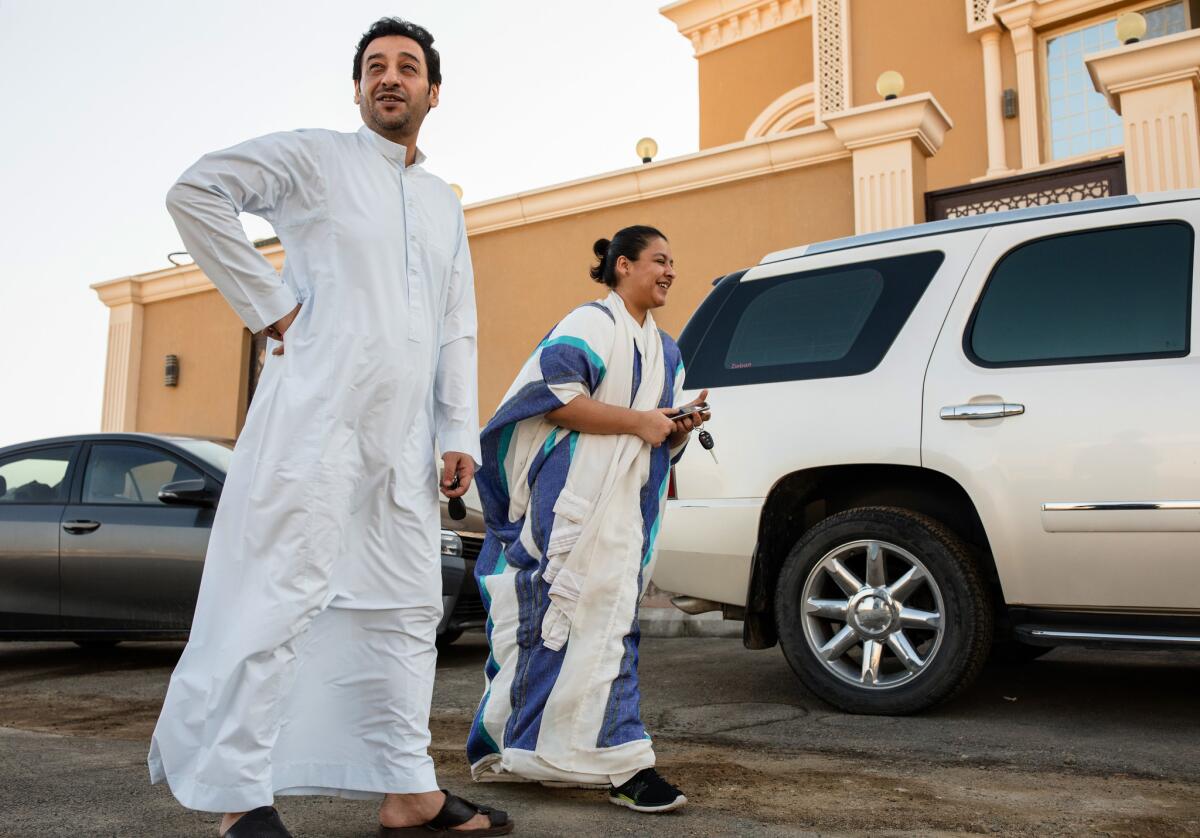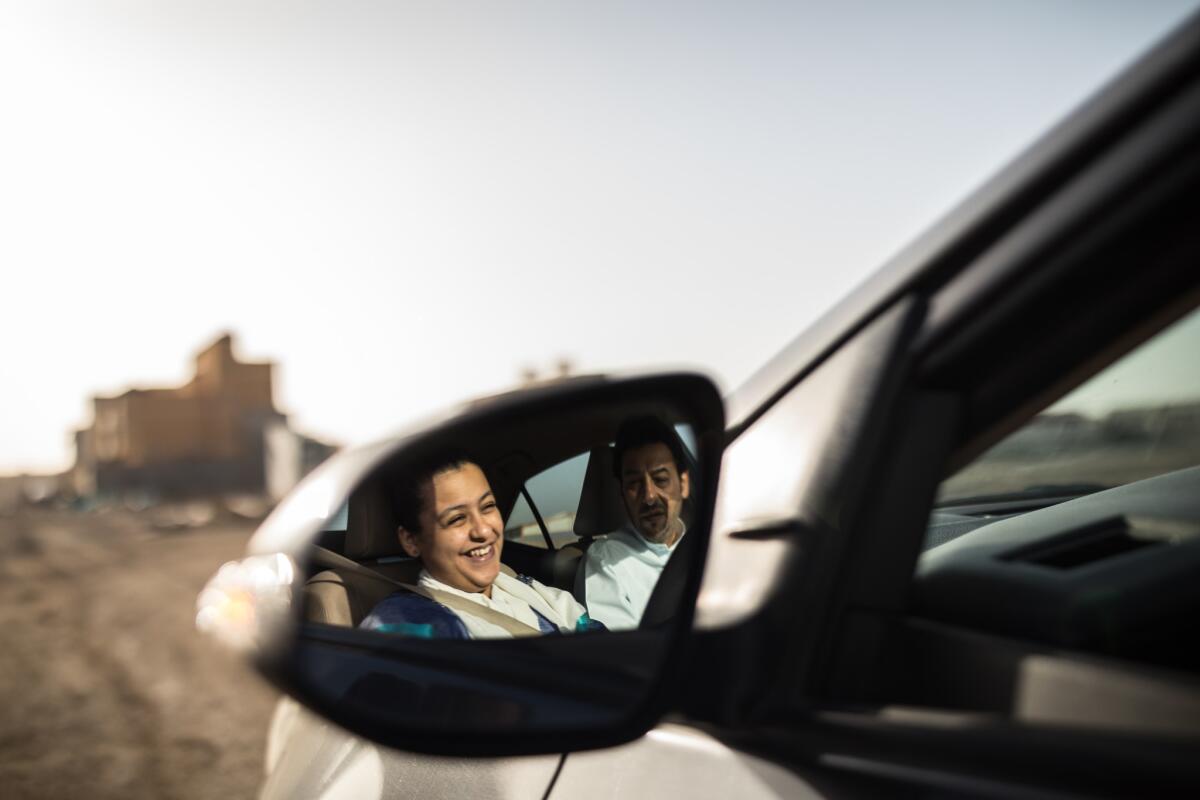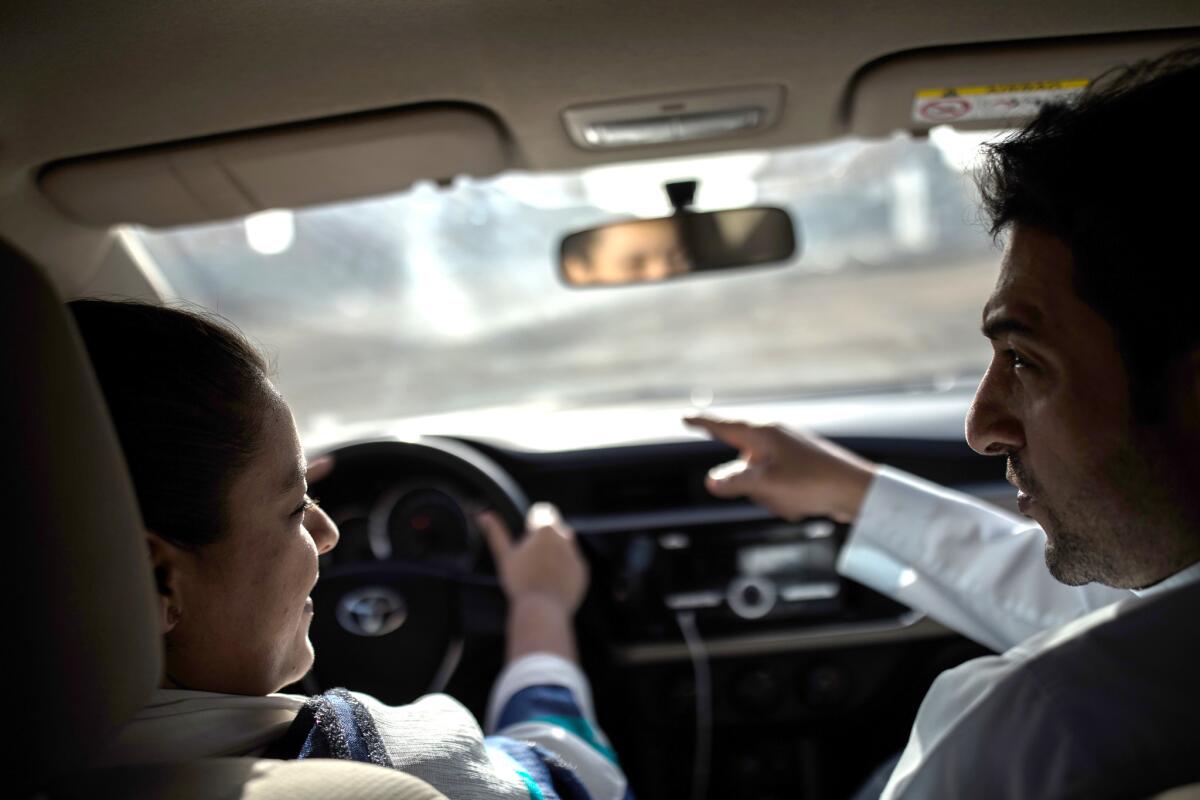Women are the bulk of ride-app customers in Saudi Arabia. Soon they will be ride-app drivers

- Share via
When 21-year-old Tala Murad needs a lift home from university or a restaurant, she frequently turns to ride-hailing apps.
It’s not just convenience. In Saudi Arabia — in contrast to every other nation — women are not allowed to drive.
That will soon change, and Murad can’t wait. Not only is she planning to get a driver’s license, but she is also planning to work for Careem, a regional service that competes here with San Francisco-based Uber.
But first she has to learn to drive. Her father is teaching her in their up-and-coming suburb of Jidda, whose quiet, unfinished streets offer an excellent training ground for an activity that technically remains illegal until the government issues regulations for women to obtain licenses.
“Slowly, slowly, enough!” he instructed her from the passenger seat of the family’s old Corolla as Murad backed up the other day.
“Like this?” she asked.
“Yes, yes,” he said with a laugh. “God help us.”
Women have been crucial in the business plans of ride-hailing apps in Saudi Arabia, an absolute monarchy that for more than three decades has enforced an ultraconservative version of Islam. Barred from driving, women make up nearly three-quarters of Uber and Careem users.
Now that the restriction is being lifted, making women less dependent on the services, the companies are moving quickly to adjust.
Less than an hour after a royal decree was announced in September clearing the way for women to obtain licenses this summer, the company launched a campaign to recruit 100,000 female drivers, or “captains,” as Careem calls them.

Uber has also announced plans to recruit female drivers. In doing so, the app companies hope to tap into a new customer segment: religiously conservative women who don’t feel comfortable getting into cars chauffeured by men who are not relatives or employed by their families.
Executives at both companies say they aren’t worried about a potential drop in revenue from Saudi Arabia.
“We really see it as opening up the business more,” said Anthony Khoury, Uber’s regional general manager.
His counterparts at Careem, which is headquartered in Dubai, United Arab Emirates, noted that the change is coming at a time when demand for ride-hailing services is increasing among Saudi men, in part because of recent hikes in the domestic price for gasoline.
“When you look at the overall market, it’s a growing pie,” said Abdulla Elyas, a Saudi national born and raised in Germany who was one of the company’s founders.
Nearly 3,000 women have signed up to drive with Careem, and the company has organized special women’s-only sessions to begin teaching them how to use its technology platform.
Just over a quarter of the women already have licenses from other countries, but most still need to learn to drive. Neither company intends to teach them, but both are looking to partner with other organizations that are accredited to do so.
Uber has been organizing “listening sessions” to solicit women’s opinions about driving and plans to open dedicated “support centers” where they can get information and training about its service. Although the response has been mostly positive, Khoury said, some women have expressed reservations about driving men, for example.
Careem will allow only women and families to summon a vehicle with a female driver, Elyas said. Other policies are still being worked out, including whether to impose any kind of dress code. The company’s male drivers are not allowed to wear shorts or flip-flops.
Elyas said women will probably be required to wear the body-concealing robe known as an abaya, which remains the norm in Saudi Arabia. But no decisions have been made about veiling. Most Saudi women cover their hair in public, and many also conceal their faces. But foreign women are not required to veil, and some locals are beginning to follow suit in parts of the country.
Some of the details will depend on what the government decides. It has said that women seeking licenses will be subject to the same requirements as men and won’t need the permission of a male guardian — which they do for other activities, including travel or study abroad.
But it is unclear whether authorities will restrict women’s ability to drive professionally in any way.
Currently, there is no law that prohibits women from driving in Saudi Arabia, but there are religious edicts issued by conservative Muslim clerics. Some clerics have argued that allowing women to drive would encourage mingling between the sexes and corrupt public morals. One suggested that driving could harm a woman’s ovaries, a notion ridiculed by many Saudis on social media.
The government, however, heeded the religious objections and refused to issue licenses to women. The de facto ban became a source of protest at home and opprobrium abroad. Some female activists were arrested for driving anyway and posting pictures of themselves behind the wheel.
The decision to allow women to drive is among recent changes pushed by the Saudi crown prince, Mohammed bin Salman, to modernize the kingdom and wean the economy from its historical dependence on oil production. The 32-year-old prince is using his ongoing swing across the United States to tout the changes as he attempts to woo investors.
Saudi officials also hope that lifting the ban will help more women enter the workforce. The low price for oil has limited the government’s ability to provide the public-sector jobs and heavily subsidized lifestyle that Saudi families have long relied on.
Though women make up more than half the kingdom's university graduates, restrictions to their mobility have impeded their job prospects. Mass-transit options are limited and used primarily by men. And there isn’t always a father, husband, brother or son available to shuttle women to work.
Families with means hire drivers to ferry around their women, but it’s an expensive proposition for many. Salaries for a personal chauffeur start around $400 a month, and because few Saudis are willing to do the work, families often face the additional expense of sponsoring a foreigner for a work permit.
Murad’s father, Midhat, said he spends between $8,000 and $9,000 a year to provide a driver for his wife and two adult daughters, because his job as a cabin manager for the national airline often takes him out of town.
But even that option is not ideal.
“Every morning, we fight over who is going to be dropped off first, and who is going to be late,” Murad said.

Murad has yearned to drive since she was little. The closest she came for many years was piloting golf carts she would beg her father to rent at the beach.
She intends to use the money she earns driving for Careem to help pay for her education. She also sees the job as a way to meet new people in a country that previously provided few opportunities for women to socialize outside their families.
Her father, too, is looking forward to the day when she can drive herself, and he can dispense with the cost of a chauffeur. He never liked the idea of her standing around waiting for a lift, especially at night. He also supports his daughter’s desire to pay her own way.
After a recent lesson with her father, Murad arrived back at their house tense, but exhilarated.
“This is independence,” she said, beaming.
Still, she has reservations about taking on Jidda’s sometimes brutal traffic.
“Even when I have a license, I will be afraid to drive on that road,” she said, eyeing a busy freeway that cuts through their neighborhood.
“See that truck?” she said, as a vehicle roared by at high speed. “There is no way I will drive with that truck.”
Twitter: @alexzavis
Sign up for Essential California
The most important California stories and recommendations in your inbox every morning.
You may occasionally receive promotional content from the Los Angeles Times.








